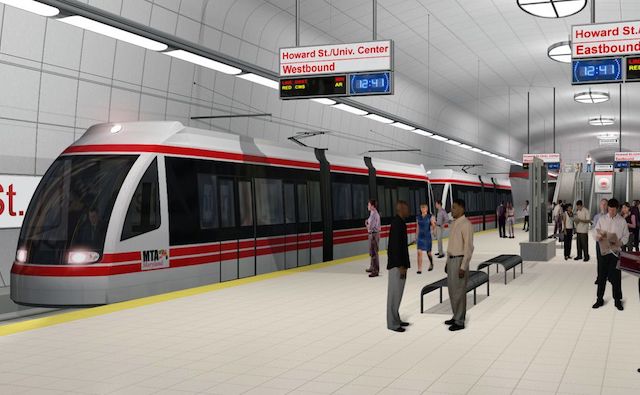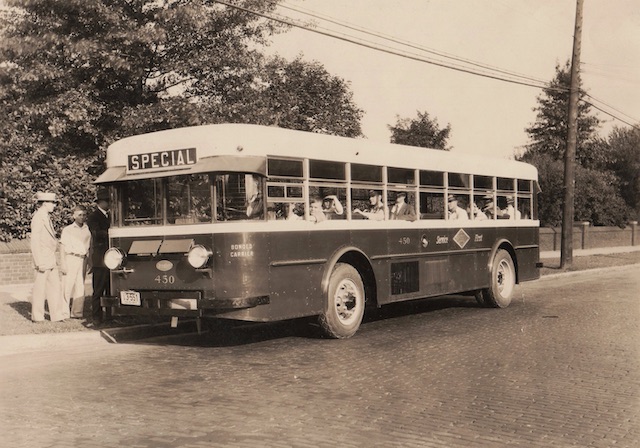A recent op-ed in the Baltimore Sun written by several elected officials proposes to “re-imagine public transit” in the Baltimore area. In particular, they want to revive the Red Line, a light-rail line that was cancelled in 2015. Among the strikes against it were that it would increase congestion and would carry so few passengers that, under FTA rules at the time, it wasn’t cost-effective and therefore wasn’t eligible for federal funding. (The rules have since been changed, but that doesn’t make it any more cost effective.)
Imagining the Baltimore Red Line.
The fact that Maryland’s governor approved the DC-area Purple Line at the same time as he cancelled the Red Line has stuck in the craw of Baltimore transit officials. Since then, the Purple Line has suffered numerous delays and cost overruns, but that doesn’t worry Baltimore’s mayor and the county executives who wrote this op-ed. Heck, they probably see cost overruns as a good thing as they would bring more money into their communities.
Introduced in 1927, the Twin Coach model 100, later renamed the model 40, revolutionized urban transit. Photo courtesy of John Fageol.
Light rail was rendered obsolete 94 years ago when Twin Coach introduced the model 100 bus, the first bus that cost less to operate, per seat-mile, than a streetcar (which is what light rail really is). Within 10 years, 500 American cities converted their streetcar lines to buses without any prodding from General Motors. (The GM streetcar conspiracy was really about GM taking market share away from Twin Coach, not about replacing streetcars.)
Despite light rail’s drawbacks, Baltimore’s elected officials think that building such an obsolete line will help make “a world-class transit system” for the city. In the 1990s, a Russian expert observed that Soviet central planners sought to build a world-class industrial economy. By the 1980s, he said, they had succeeded in building the finest nineteenth-century industrial economy in the world. By that time, of course, the rest of the developed world had gone well beyond heavy industry and into the knowledge economy, emphasizing software and telecommunications rather than steel and railroads. It seems that one of the hazards of government planners is they spend more time looking backwards than forwards.
The elected officials who wrote this op-ed think Baltimore is still a nineteenth-century city, where most of the jobs are downtown and most workers commute to those jobs on streetcars. But, according to demographer Wendell Cox, only 6.3 percent of Baltimore-area jobs are located in its downtown. A big-box transit system on rails simply doesn’t work in an urban area where jobs are spread throughout the area.
In 2021, the average Baltimore bus had 39 seats and room for 37 more people standing, yet it carried an average of less than 8 passengers at a time (measured by dividing passenger-miles by vehicle-revenue miles), which means less than 20 percent of the seats were filled and just 10 percent of the total bus capacities. What Baltimore needs is not trains capable of carrying 450 people at a time that can only operate 20 times an hour but smaller buses capable of going to more destinations more frequently.
I’m not even certain Baltimore needs public transit at all. In 2021, fewer than 50,000 workers in the Baltimore urban area — 4.4 percent of the total — lived in households without an automobile, and less than a third of those took transit to work while more than a third either drove alone to work or carpooled. Another 65,000 workers lived in households where all available automobiles could be claimed by other workers in the household, and carpooling only works if work schedules are aligned and workplaces are in the same direction.
The solution for these people is not multi-billion dollar subsidies for a high-cost, low-capacity transit line that probably won’t go where they want but financial assistance for buying a good used car. As I’ve noted here before, the biggest barrier to car ownership for most low-income people is that banks will charge 20 to 25 percent interest for used-car loans to people who have poor credit ratings. A low-interest loan system would cost little and yet help many people who lack an automobile out of poverty by giving them access to more jobs, better housing, and lower-cost consumer goods.
Building an expensive, obsolete transit line won’t make Baltimore a world-class city. It will make Baltimore officials world-class chumps as the main beneficiaries of such construction will be consultants and contractors, not Baltimore taxpayers.










“It will make Baltimore officials world-class chumps … ”
The real chumps will be the taxpayers who ultimately pay the bill.
Yes, but the idea is always laughed at.
Aging rail stock is impossible to fix without replacement and that requires shutdown in order.
Roads can be repaired one lane at a time if need be…
Real solution to train debacle is simple. Buses that resemble trains…..
https://upload.wikimedia.org/wikipedia/commons/thumb/0/0c/NishiTokyoBus_C20782_New-Seishungou.jpg/440px-NishiTokyoBus_C20782_New-Seishungou.jpg
2021, the average Baltimore bus had 39 seats and room for 37 more people standing, yet it carried an average of less than 8 passengers at a time
For what it costs transit agencies you could ferry the passenger load in Rolls Royces for less money.
i think the only way this ends is sharply curtail federal subsidies for mass transit, then privatize major urban systems and fund them like the asians do, through property tax revenue.
freddieM,
Why should people, who don’t and won’t use passenger trains, continue to fund something that clearly makes no sense in 2023?
i don’t disagree. but a loud minority seems to want them.
the problem comes about because they are unconnected from the actual cost of providing the service.
we are hyper aware of how much a dozen eggs or a gallon of gasoline costs, and moderate our consumption appropriately.
why do transit people get a pass that most of us don’t?
communities who had to pony up the money from their own pockets to provide the service might make better, more cost effective choices.
It’s hard to imagine how this will ever end…or even THAT it will ever end.
Somebody once said, “It’s easier to fool somebody than to convince them they’ve been fooled.”
That’s complicated by the fact that there already so few of us who know they’ve been fooled and are trying to convince them.
I’ve always said that, for every transit boondoggle in this country, there’s a score of professional state and federal government employees who have signed off on it.
When was the last time any of us witnessed a FTA or FHWA official say, “Hey, that will fail.” Does anybody here know of a situation where a knowledgeable scientist at, say, EPA has ever pointed out that a half full diesel locomotive generates more pollution than the cars it would take to replace it?
Billions of dollars of CMAQ money has been spent on projects that have exacerbated air pollution because nobody with the authority stop it cares enough to stop it.
A lot of evil is perpetrated with a rubber stamp!